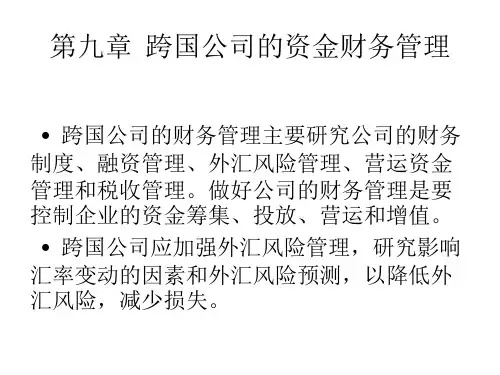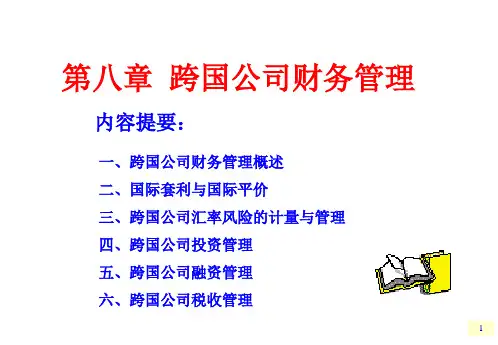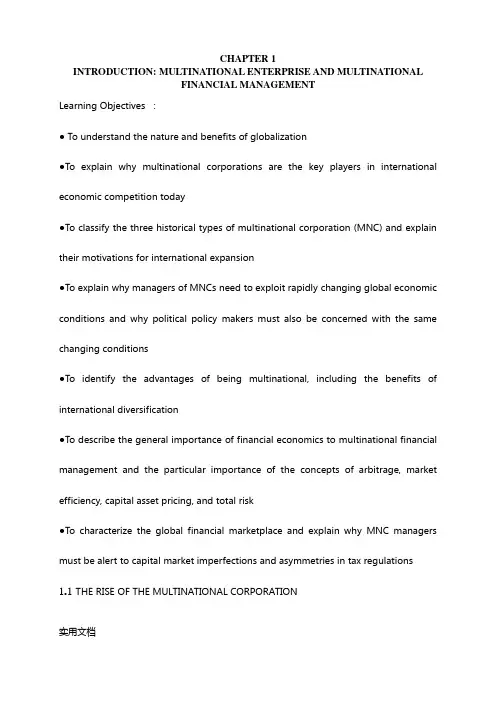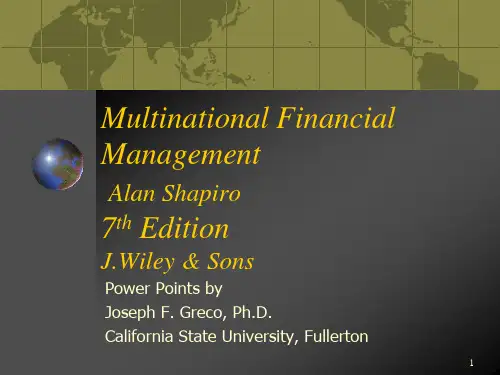跨国公司财务管理讲义
- 格式:ppt
- 大小:1.26 MB
- 文档页数:38






CHAPTER 1INTRODUCTION: MULTINATIONAL ENTERPRISE AND MULTINATIONALFINANCIAL MANAGEMENTLearning Objectives :● To understand the nature and benefits of globalization●To explain why multinational corporations are the key players in international economic competition today●To classify the three historical types of multinational corporation (MNC) and explain their motivations for international expansion●To explain why managers of MNCs need to exploit rapidly changing global economic conditions and why political policy makers must also be concerned with the same changing conditions●To identify the advantages of being multinational, including the benefits of international diversification●To describe the general importance of financial economics to multinational financial management and the particular importance of the concepts of arbitrage, market efficiency, capital asset pricing, and total risk●To characterize the global financial marketplace and explain why MNC managers must be alert to capital market imperfections and asymmetries in tax regulations1.1 THE RISE OF THE MULTINATIONAL CORPORATION实用文档1.1.1A multinational corporation (MNC) is a company engaged in producing and selling goods or services in more than one country.1.1.2A brief taxonomy of the MNC and its evolutionRaw-Materials Seekers. Raw-materials seekers were the earliest multinationals, the villains of international business.Market Seekers. The market seeker is the archetype of the modern multinational firm that goes overseas to produce and sell in foreign markets.Cost Minimizers. These firms seek out and invest in lower cost production sites overseas (for example, Hong Kong, Taiwan, and Ireland) to remain cost-competitive both at home and abroad.1.1.3the true multinational corporation is characterized more by its state of mind than by the size and worldwide dispersion of its assets.1.1.4the essential element that distinguishes the true multinational is its commitment to seeking out, undertaking, and integrating manufacturing, marketing, R&D, and financing opportunities on a global, not domestic, basis.1.1.5In a world in which change is the rule and not the exception, the key to international competitiveness is the ability of management to adjust to change and volatility at an ever faster rate.1.1.6New global manager is needed.实用文档1.2 THE INTERNATIONALIZATION OF BUSINESS AND FINANCE1.2.1The existence of global competition and global markets for goods, services, and capital is a fundamental economic reality that has altered the behavior of companies and governments worldwide.1.2.2Politicians and labor leaders, unlike corporate leaders, usually take a more parochial view of globalization.1.2.3International economic integration reduces the freedom of governments to determine their own economic policy.1.2.4The stresses caused by global competition have stirred up protectionists and given rise to new concerns about the consequences of free trade.The U.S.–Canada trade agreement; the North American Free Trade Agreement (NAFTA),1.3 MULTINATIONAL FINANCIAL MANAGEMENT: THEORY AND PRACTICE1.3.1The main objective of multinational financial management is to maximize shareholder wealth as measured by share price.1.3.2Shareholders are the legal owners of the firm and management has a fiduciary obligation to act in their best interests.1.3.3Financial management is traditionally separated into two basic functions: theacquisition of funds (financing decision) and the investment of those funds 实用文档(investment decision).1.3.4The risks of multinational management include exchange and inflation risks; international differences in tax rates; multiple money markets, often with limited access; currency controls; and political risks, such as sudden or creeping expropriation.1.3.5The most advantage of MNC is the international diversification of markets and production sites.1.3.6Some concepts of financial economics:Arbitrage Market efficiency Capital Asset Pricing Risk classification1.4 OUTLINE OF THE BOOKThis book is divided into five parts.Part I: Environment of International Financial ManagementPart II: Foreign Exchange Risk ManagementPart III: Financing the Multinational CorporationPart IV: Foreign Investment AnalysisPart V: Multinational Working Capital ManagementCHAPTER 2THE FUNDAMENTAL OF INTERNATIONAL FINANCELearning Objectives:实用文档●To explain the concept of an equilibrium exchange rate●To identify the basic factors affecting exchange rates in a floating exchange rate system●To calculate the amount of currency appreciation or dep reciation associated with a given exchange rate change●To distinguish between a free float, a managed float, a target-zone arrangement, anda fixed-rate system of exchange rate determination●To distinguish between the current account, the financial accou nt, and the official reserves account and describe the links among these accounts2.1 SETTING THE EQUILIBRIUM SPOT EXCHANGE RATE2.1.1Exchange rates can be for spot or forward delivery.2.1.2A spot rate is the price at which currencies are traded for immediate delivery, or in two days in the interbank market.2.1.3A forward rate is the price at which foreign exchange is quoted for delivery at a specified future date.2.1.4The exchange rates are market-clearing prices that equilibrate supplies and demands in the foreign exchange market.2.1.5Factors that Affect the Equilibrium Exchange Rate:As the supply and demand schedules for a currency change over time, the equilibrium 实用文档exchange will also change.Relative Inflation Rates Relative Interest Rates Relative Economic Growth Rates Political and Economic Risk Expectation and Asset Market model2.1.6Calculating Exchange Rate Change2.2 ALTERNATIVE EXCHANGE RATE SYSTEMS2.2.1The international monetary system refers primarily to the set of policies, institutions, practices, regulations, and mechanisms that determine the rate at which one currency is exchanged for another.2.2.2This section considers five market mechanisms for establishing exchange rates: free float managed float target-zone arrangementfixed-rate system the current hybrid system.2.3 BALANCE-OF-PAYMENT CATEGORIES2.3.1The balance of payment is an accounting statement that summarizes all the economic transactions between residents of the home country and the residents of all other countries.2.3.2Currency inflows are recorded as credits, and outflows are recorded as debits. 2.3.3There are three principal balance-of-payments categories:1. Current account2. Capital account3. Financial account2.3.4For most countries, only the current and financial accounts are significant.实用文档CHAPTER 3COUNTRY RISK ANALYSISLearning Objectives:● To define what country risk means from the standpoint of an MNC● To describe the social, cultural, political, and economic factors that affect the gene ral level of risk in a country and identify key indicators of country risk and economic health ● To describe what we can learn about economic development from the contrasting experiences of a variety of countries● To describe the economic and political factors that determine a country’s ability and willingness to repay its foreign debts3.1 MEASURING POLITICAL RISK3.1.1Expropriation is the most obvious and extreme form of political risk,.3.1.2There are other significant political risks, including currency or trade controls, changes in tax or labor laws, regulatory restrictions, and requirements for additional local production.3.1.3Factors in political risk forecasting modelPolitical Stability Economic Factors Subjective FactorPolitical Risk and Uncertain Property Rights3.1.4A useful indicator of the degree of political risk is the seriousness of capital flight.实用文档3.2 ECONOMIC AND POLITICAL FACTORS UNDERLYING COUNTRY RISK3.2.1key factors that determine the economic performance of a country and its degree of riskFiscal Irresponsibility Monetary Instability Controlled Exchange Rate System Wasteful Government Spending Resource BaseCountry Risk and Adjustment to External Shocks3.2.2Key Indicators of Country Risk and Economic Health3.3 COUNTRY RISK ANALYSIS IN INTERNATIONAL BANKING3.3.1From a bank’s standpoint, country risk is the possibility that borrowers in a country will be unable or unwilling to service or repay their debts to foreign lenders ina timely manner.3.3.2What ultimately det ermines a nation’s ability to repay foreign loans is that nation’s ability to generate U.S. dollars and other hard currencies.3.3.3The Government’s Cost/Benefit Calculus3.3.4Lessons from the International Debt CrisisCHAPTER 4MEASURING AND MANAGING TRANSLATION AND TRANSACTION EXPOSURE Learning Objectives● To define translation and transaction exposure and operating exposure, distinguish 实用文档them.● To describe the four principal currency translation methods available and to calculate translation exposure using these different methods● To identify the basic hedging strategy and techniques used by firms to manage their currency transaction and translation risks● To describe the costs and benefit associated with using the different hedging techniques● To describe and assess the economic soundness of the various corporate hedging objectives4.1 ALTERNATIVE MEASURES OF FOREIGN EXCHANGE EXPOSURE4.1.1The three basic types of exposure are translation exposure, transaction exposure, and operating exposure.4.1.2Transaction exposure and operating exposure combine to form economic exposure.Translation exposure, also known as accounting exposure, arises from the need, for purposes of reporting and consolidation, to convert the financial statements of foreign operations from the local currencies (LC) involved to the home currency (HC). Transaction exposure results from transactions that give rise to known, contractuallybinding future foreign-currency-denominated cash inflows or outflows.实用文档Operating exposure measures the extent to which currency fluctuations can alter acompany’s future operating cash flows, that is, its future revenues and costs.4.2 ALTERNATIVE CURRENCY TRANSLATION METHODS4.2.1Companies with international operations will have foreign-currency-denominated assets and liabilities, revenues, and expenses. The financial statements of an MNC’s overseas subsidiaries must be translated from local currency to home currency before consolidation with the parent’s financial statements.4.2.2Four principal translation methods are available:the current/noncurrent method, the monetary/nonmonetary method,the temporal method, and the current rate method.4.2.3In practice, there are also variations of each method.4.2.4Current/Noncurrent methodAll the foreign subsidiary’s current assets and liabilities are translated into home currency at the current exchange rate. Each noncurrent asset or liability is translated at its historical exchange rate—that is, at the rate in effect at the time the asset was acquired or the liability was incurred.The income statement is translated at the average exchange rate of the period, except for those revenues and expense items associated with noncurrent assets or libilities.4.2.5Monetary/Nonmonetary Method实用文档Monetary items (for example, cash, accounts payable and receivable, and long-termdebt) are translated at the current rate; nonmonetary items (for example, inventory, fixed assets, and long-term investments) are translated at historical rates.Income statement items are translated at the average exchange rate during the period, except for revenue and expense items related to nonmonetary assets and liabilities. 4.2.6Temporal MethodUnder the temporal method, inventory is normally translated at the historical rate, but it can be translated at the current rate if the inventory is shown on the balance sheet at market values.in the temporal method, it is based on the underlying approach to evaluating cost (historical versus market).Income statement items normally are translated at an average rate for the reporting period.4.2.7Current Rate MethodThe current rate method is the simplest: All balance sheet and income items are translated at the current rate.4.4 DESIGNING A HEDGING STRATEGY4.4.1Hedging a particular currency exposure means establishing an offsetting currencyposition so as to lock in a dollar (home currency) value for the currency exposure and 实用文档thereby eliminate the risk posed by currency fluctuations.4.4.2The usefulness of a particular hedging strategy depends on both acceptability and quality.4.4.3The objectives in management bahaviorMinimize translation exposure; Minimize earnings fluctuations owing to exchange rate changes; Minimize transaction exposure; Minimize economic exposure; Minimize foreign exchange risk management costs; Avoid surprises4.4.4Costs and Benefits of Standard Hedging Techniques4.4.5Exposure NettingExposure netting involves offsetting exposures in one currency with exposures in the same or another currency, where exchange rates are expected to move in a way such that losses (gains) on the first exposed position will be offset by gains (losses) on the second currency exposure.4.4.6Accounting for Hedging and FASB 1334.5 MANAGING TRANSLATION EXPOSURE4.5.1Firms have three available methods for managing their translation exposure: (1) adjusting fund flows, (2) entering into forward contracts, and (3) exposure netting. 4.5.2Funds adjustment involves altering either the amounts or the currencies (or both)of the planned cash flows of the parent or its subsidiaries to reduce the firm’s local 实用文档currency accounting exposure.4.5.3Evaluating Alternative Hedging Mechanisms4.5.4Ordinarily, the selection of a funds-adjustment strategy cannot proceed by evaluating each possible technique separately without risking suboptimization.4.6 MANAGING TRANSACTION EXPOSUREVarious techniques for managing transaction exposure Forward Market Hedge Money-Market Hedge Risk shifting Pricing Decision Exposure netting Currency Risk Sharing Currency Collars Cross-Hedging Foreign Currency OptionsCHAPTER 5MEASURING AND MANAGING ECONOMIC EXPOSURELearning Objectives● To define economic exposure and exchange risk and distinguish between the two ● To define operating exposure and distinguish b etween it and transaction exposure ● To identify the basic factors that determine the foreign exchange risk faced by a particular company or project● To describe the marketing, production, and financial strategies that are appropriate for coping with the economic consequences of exchange rate changes● To explain how companies can develop contingency plans to cope with exchange risk 实用文档and the consequences of their ability to rapidly respond to currency changes● To identify the role of the financial exec utive in facilitating the operation of an integrated exchange risk management program5.1 FOREIGN EXCHANGE RISK AND ECONOMIC EXPOSURE5.1.1The most important aspect of foreign exchange risk management is to incorporate currency change expectations into all basic corporate decisions.5.1.2Economic exposure can be separated into two components: transaction exposure and operating exposure.5.1.3The exchange rate changes that give rise to operating exposure are real exchange rate changes. The real exchange rate is defined as the nominal exchange rate adjusted for changes in the relative purchasing power of each currency since some base period.5.2 THE ECONOMIC CONSEQUENCES OF EXCHANGE RATE CHANGES5.2.1Transaction exposure arises out of the various types of transactions that require settlement in a foreign currency.5.2.2The greater a company’s flexibility to substitute between home-country and foreign-country inputs or production, the less exchange risk the company will face. 5.2.3The major conclusion is that the sector of the economy in which a firm operates (export, import-competing, or purely domestic), the sources of the firm’s inputs(imports, domestic traded or nontraded goods), and fluctuations in the real exchange 实用文档rate are far more important in delineat ing the firm’s true economic exposure than isany accounting definition.5.3 IDENTIFYING ECONOMIC EXPOSUREAspen Skiing Company Petróleos Mexicanos Toyota Motor Company5.4 CALCULATING ECONOMIC EXPOSURE4.4.1Spectrum Manufacturing AB example5.4.2Spect rum’s Accounting Exposure5.4.3Spectrum’s Economic ExposureScenario 1: All Variables Remain the Same.Scenario 2: Krona Sales Prices and All Costs Rise; Volume Remains the Same. Scenario 3: Partial Increases in Prices, Costs, and Volume.5.6 MANAGING OPERATING EXPOSURE5.6.1Because currency risk affects all facets of a company’s operations, it should not be the concern of financial managers alone.5.6.2Marketing Management of Exchange RiskMarket Selection Pricing Strategy Product Strategy5.6.3Production Management of Exchange RiskInput Mix Shifting Production Among Plants Plant Location RaisingProductivity实用文档5.6.4Planning for Exchange Rate Changes5.6.5Financial Management of Exchange RiskCHAPTER 6INTERNATIONAL FINANCING AND NATIONAL CAPITAL MARKETS Learning Objectives● To describe trends and differences in corporate financing patterns around the world ● To define securitization and explain the forces that underlie it and how it has affected the financing policies of MNCs● To explain why bank lending is on the decline worldwide and how banks have responded to their loss of market share● To explain what is meant by the globalization of financial markets and identify the factors that have affected the process of globalization● To descri be the external medium and long-term financing options available to the multinational corporation● To identify the functions and consequences of financial markets● To describe the links between national and international capital markets● To describe the types and roles of development banks6.1 CORPORATE SOURCES AND USES OF FUNDS6.1.1Firms have three general sources of funds available: internally generated cash, 实用文档short-term external funds, and long-term external funds.6.1.2Financial Markets versus Financial IntermediariesBank borrowing vs sell securities6.1.3Financial Systems and Corporate GovernanceAffective corporate governance requires that everyone involved in governing the company must be assigned a carefully chosen role and they must be provided with responsibility, authority, and accountability, all to be done with the paramount objective of creating shareholder value.The difference in financial systems has real consequences for financial structures.6.1.4Globalization of Financial Markets6.2NATIONAL CAPITAL MARKETS AS INTERNATIONAL FINANCIAL CENTERS6.2.1The principal functions of a financial market and its intermediaries are to mobilize savings and to allocate those funds among potential users on the basis of expected risk-adjusted returns.6.2.2International Financial Markets6.2.3Foreign access to domestic MarketsThe foreign bond market The foreign bank market The foreign equity market6.2.4Globalization of financial markets has its downside6.3 DEVELOPMENT BANK实用文档6.3.1To help provide the huge financial resources required to promote the development of economically backward areas, the United States and other countries have established a variety of development banks, whose lending is directed to investments that might not otherwise be funded by private capital.6.3.2There are three types of development banks:the World Bank Group, regional development banks, and national development banks.6.3.3Private-Sector AlternativesCHAPTER 7THE EUROMARKETSLearning Objectives● To describ e the Eurocurrency and Eurobond markets and explain why they exist● To describe the characteristics and pricing of Eurocurrency loans, Eurobonds, Euronotes, and Euro-commercial paper● To explain the links between the Euromarkets and their domestic coun terparts7.1 THE EUROCURRENCY MARKET7.1.1A Eurocurrency is a dollar or other freely convertible currency deposited in a bank outside its country of origin.7.1.2U.S. dollars on deposit in London become Eurodollars.实用文档7.1.3The Eurocurrency market then consists of those banks—called Eurobanks—that accept deposits and make loans in foreign currencies.7.1.4Modern Origins of Eurocurrency7.1.5The creation of Eurodollar7.1.6Eurocurrency Loans7.1.7Relationship Between Domestic and Eurocurrency Money MarketsThe presence of arbitrage activities ensures a close relationship between interest rates in national and international (Eurocurrency) money markets.Interest DifferentialsEurocurrency Spreads7.1.8Euromarket Trend7.2 EUROBONDS7.2.1Unlike domestic bond markets, however, the Eurobond market is almost entirely free of official regulation and is instead self-regulated by the Association of International Bond Dealers.7.2.2Borrowers in the Eurobond market are typically well known and have impeccable credit ratings.7.2.3Links Between the Domestic and Eurobond MarketsPlacement Currency Denomination Interest rates实用文档Eurobond Retirement Ratings7.2.4Rational for Existence of Eurobond Market7.2.5Eurobonds versus Eurocurrency LoansCost of borrowing Maturity Size of issue Flexibility Speed7.3 NOTE ISSUANCE FACILITIES AND EURONOTES7.3.1The note issuance facility (NIF) allows borrowers to issue their own short-term Euronotes, which are then placed or distributed by the financial institutions providing the NIF.7.3.2Note Issuance Facilities versus EurobondsDrawdown flexibility Timing flexibility Choice of maturities7.3.3Euro-Medium-Term Notes 7.3.4Euro-Commercial Paper 7.3.5The Asiacurrency MarketCHAPTER 8THE COST OF CAPITAL FOR FOREIGN INVESTMENTSLearning Objectives● To determine the cost of capital for foreign investments and identify those circumstances under which that cost should be higher, lower, or the same as that for comparable domestic projects● To identify and address the key issu es involved in applying the capital asset pricing 实用文档model to estimate the cost of capital for foreign projects● To illustrate the impact of globalization on the cost of capital● To calculate the effective dollar costs of foreign currency borrowing taking into account interest rates, exchange rate changes, and taxes● To identify the relevant factors and tradeoffs in establishing a company’s worldwide capital structure● To calculate the value of below-market financing opportunities8.1 THE COST OF EQUITY CAPITAL8.1.1The cost of equity capital for a firm is the minimum rate of return necessary to induce investors to buy or hold the firm’s stock.8.1.2The Capital asset pricing model8.1.3The CAPM is based on the notion that intelligent, risk-averse shareholders will seek to diversify their risks, and, as a consequence, the only risk that will be rewarded with a risk premium will be systematic risk.8.1.4Weighted average cost of capital8.3 DISCOUNT RATES FOR FOREIGN INVESTMENTS8.3.1Key Issues in Estimating Foreign Project Discount Rates1. Should the corporate proxies be U.S. or local (i.e., foreign) companies?2. Is the relevant base portfolio against which the proxy betas are estimated the U.S. 实用文档market portfolio, the local portfolio, or the world market portfolio?3. Should the market risk premium be based on the U.S. market or the local market?4. How, if at all, should country risk be incorporated in the cost of capital estimates? 8.3.2Three alternatives for estimating proxy betas are proposed here.Local Companies Proxy Industry Adjusted U.S. Industry Beta8.3.3In employing the CAPM, the base portfolio against which the proxy betas are estimated can be the home portfolio or the global market portfolio.8.3.4The Impact of Globalization on the Cost of CapitalOther things being equal, the use of a global CAPM means a lower cost of capital for this company.8.3.5Empirical Evidence8.3.6The Relevant Market Risk Premium8.5 ESTABLISHING A WORLDWIDE CAPITAL STRUCTURE8.5.1The Cost of Debt CapitalIn general, the after-tax dollar cost of borrowing in the local currency for a foreign affiliate equals the after-tax interest expense plus the change in the exchange rate. 8.5.2The capital structure problem for the multinational enterprise is to determine the mix of debt and equity for the parent entity and for all consolidated andunconsolidated subsidiaries that maximizes shareholder wealth.实用文档8.5.3Foreign Subsidiary Capital StructureConform to the capital structure of the parent companyReflect the capitalization norms in each foreign countryVary to take advantage of opportunities to minimize the MNC’s cost of capital8.5.4Political Risk Management 8.5.5Currency Risk Management8.5.6Leverage and Foreign Tax Credit 8.5.7Leasing and Taxes8.5.8Cost-Minimizing Approach to Global Capital Structure8.5.9Valuing Low-Cost Financing OpportunitiesTaxes Zero-Coupon Bonds Debt versus Equity Financing8.5.10Government Credit and Capital Control 8.5.11Government Subsidies and IncentivesCHAPTER9INTERNATIONAL PORTFOLIO INVESTMENTLearning Objectives● To describe the risks and advantages of international investing● To explain how international investing can allow investors to achieve a better risk-return trade-off than by investing solely in U.S. securities● To identify the barriers to investing overseas实用文档● To describe the various ways in which U.S. investors can diversify into foreignsecurities● To calculate the currency risk associated with investing in securities issued in different markets and denominated in various currencies● To calculate the return associated with investing in securities issued in different markets and denominated in various currencies9.1 THE RISKS AND BENEFITS OF INTERNATIONAL EQUITY INVESTING9.1.1The risks of international investing1. Changes in currency exchange rates2. Dramatic changes in market value3. Political, economic, and social events4. Lack of liquidity5. Less information6. Reliance on foreign legal remedies7. Different market operations9.1.2This relation follows from the basic rule of portfolio diversification: The broader the diversification, the more stable the returns and the more diffuse the risks.9.1.3Correlations and the Gains from DiversificationForeign market betas, which are a measure of market risk derived from the capital asset pricing model, are calculated relative to the U.S. market in the same way that individual asset betas are calculatedThe obvious conclusion is that international diversification pushes out the efficientfrontier—the set of portfolios that has the smallest possible standard deviation for its 实用文档level of expected return and has the maximum expected return for a given level ofrisk—allowing investors simultaneously to reduce their risk and increase their expected return.9.1.4Investing in Emerging Markets 9.1.5Barriers to international Diversification9.2INTERNATIONAL PORTFOLIO INVESTMENT1International Bond Investment2Optimal International Asset Allocation3Measuring the Total Return From Foreign Portfolio InvestingIn general, the total dollar return on an investment can be divided into three separate elements: dividend/interest income, capital gains (losses), and currency gains (losses). Bond; stock4Measuring Exchange Risk on Foreign SecuritiesCHAPTER10CORPORATE STRATEGY AND FOREIGN DIRECT INVESTMENT Learning Objectives● To identify the stages of corporate expansion overseas by which companies gradually become multinational corporations (MNCs)● To identify the fundamental motives for companies to invest abroad in order t odetermine those foreign investments that are most likely to be successful实用文档。



